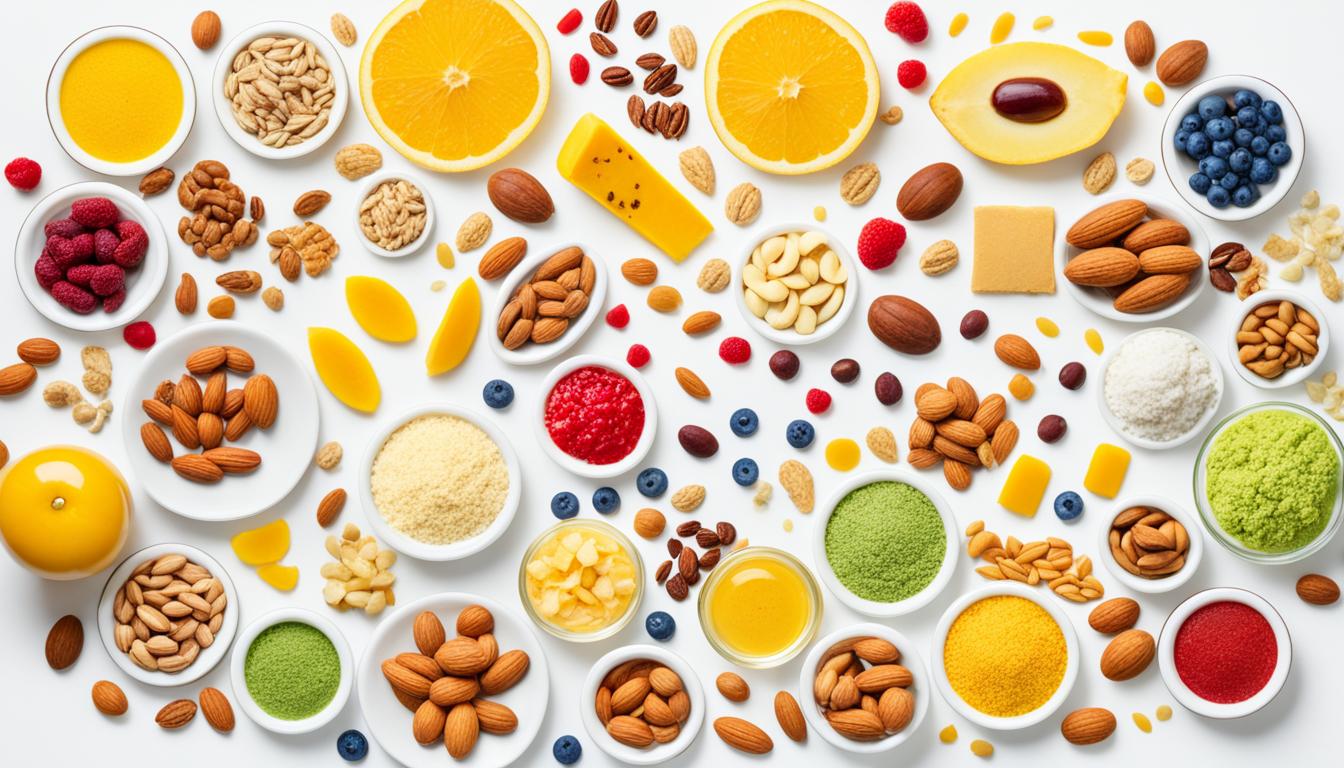
Welcome to the world of food hypersensitivity. If you’ve ever experienced adverse reactions after eating certain foods, it’s essential to understand the different categories of food hypersensitivity. By knowing the specific type of reaction you’re experiencing, you can make informed choices and take the necessary steps to manage your condition effectively.
Key Takeaways:
- Food hypersensitivity refers to adverse reactions to certain foods.
- There are four primary categories of food hypersensitivity: food allergies, food intolerances, non-IgE mediated hypersensitivity, and oral allergy syndrome.
- Food allergies involve an immune response triggered by specific foods and are characterized by the production of immunoglobulin E (IgE) antibodies.
- Food intolerances do not involve the immune system but result in digestive symptoms after consuming certain foods.
- Non-IgE mediated hypersensitivity and oral allergy syndrome are additional types of food hypersensitivity that have different mechanisms and symptoms.
Now, let’s delve into each category to gain a deeper understanding of how they can impact your health and dietary choices.
Understanding Food Allergies
When it comes to food allergies, your immune system plays a crucial role. Food allergies occur when your immune system mistakenly identifies certain foods as harmful and launches an immune response to protect your body from what it perceives as a threat. This immune response is triggered by a specific type of antibody called immunoglobulin E, or IgE for short.
IgE antibodies are responsible for recognizing and binding to the proteins found in certain foods that you’re allergic to. When an allergic individual consumes these foods, the immune system releases chemicals, such as histamine, which cause the symptoms associated with food allergies.
Food allergy symptoms can range from mild to severe and may include itching, hives, swelling, difficulty breathing, chest tightness, vomiting, diarrhea, and even life-threatening reactions known as anaphylaxis.
“Food allergies involve an immune response triggered by specific foods.”
Common Food Allergens
Several foods are known to be common allergens and can trigger an allergic reaction in susceptible individuals. The most common food allergens include:
- Milk
- Eggs
- Wheat
- Soy
- Peanuts
- Tree nuts
- Fish
- Shellfish
If you suspect that you or someone you know has a food allergy, it’s important to seek medical advice for proper diagnosis and management. Allergic reactions can be unpredictable, and even trace amounts of allergens can trigger severe symptoms.
Food Allergy Testing
There are various methods of testing for food allergies, including skin prick tests, blood tests, and oral food challenges. These tests can help identify specific food allergens and determine the severity of the allergy.
If a food allergy is diagnosed, the best course of action is to avoid consuming the allergenic food completely. Reading food labels carefully, communicating with restaurant staff about your allergies, and carrying emergency medications, such as epinephrine auto-injectors, can help prevent and manage allergic reactions.
Exploring Food Intolerances
In the realm of food hypersensitivity, it’s essential to distinguish between food allergies and food intolerances. While both can cause unpleasant symptoms, food intolerances do not involve the immune system. Rather, they occur when your body has difficulty digesting certain foods or components of foods.
Common types of food intolerance include lactose intolerance, gluten intolerance (non-celiac gluten sensitivity), fructose malabsorption, and histamine intolerance. Each of these intolerances manifests differently in the body and can lead to a range of symptoms.
Let’s take a closer look at some of the most prevalent food intolerances:
Lactose Intolerance
Lactose intolerance occurs when your body lacks the enzyme lactase, which helps digest lactose, a sugar found in milk and dairy products. Without enough lactase, lactose passes undigested into the colon, causing uncomfortable symptoms such as bloating, diarrhea, and gas.
Gluten Intolerance (Non-Celiac Gluten Sensitivity)
Gluten intolerance, also known as non-celiac gluten sensitivity, refers to the inability to digest gluten, a protein found in wheat, barley, and rye. Individuals with gluten intolerance may experience symptoms similar to those with celiac disease, such as abdominal pain, bloating, and fatigue, but without the same immune system reaction.
Fructose Malabsorption
Fructose malabsorption occurs when your body has difficulty absorbing fructose, a sugar found in fruits, honey, and certain vegetables. This intolerance can lead to abdominal pain, bloating, diarrhea, and gas.
Histamine Intolerance
Histamine intolerance is characterized by an inability to process histamine, a compound naturally present in certain foods. Foods high in histamine, such as aged cheese, fermented products, and cured meats, can trigger symptoms like headaches, hives, nasal congestion, and gastrointestinal discomfort.
Understanding these common food intolerances is crucial for managing your dietary choices and ensuring optimal well-being. By identifying and avoiding trigger foods, individuals with food intolerances can reduce symptoms and improve their overall quality of life.
To provide a comprehensive overview of these food intolerances, refer to the following table:
| Food Intolerance Type | Symptoms | Common Trigger Foods |
|---|---|---|
| Lactose Intolerance | Abdominal pain, bloating, gas, diarrhea | Milk, cheese, ice cream, yogurt |
| Gluten Intolerance | Abdominal pain, bloating, fatigue | Wheat, barley, rye, processed foods containing gluten |
| Fructose Malabsorption | Abdominal pain, bloating, diarrhea, gas | Apples, pears, honey, high-fructose corn syrup |
| Histamine Intolerance | Headaches, hives, nasal congestion, gastrointestinal discomfort | Aged cheese, fermented foods, cured meats |
By recognizing the specific food intolerances you may have, you can make informed decisions when planning your meals and selecting ingredients that support your health and well-being.
Cross-Reactivity in Food Hypersensitivity
In individuals with existing allergies, cross-reactivity can occur when proteins in one food trigger a reaction. It’s essential to understand common cross-reactivity patterns to effectively manage food hypersensitivity.
Certain proteins in foods can share similar structures or epitopes with proteins in other foods, leading to cross-reactivity. When someone with an existing allergy consumes a food containing these similar proteins, their immune system may mistake it for the allergenic protein and trigger an allergic reaction.
For example, individuals allergic to birch pollen may experience cross-reactivity when consuming apples or carrots due to the shared proteins between these foods.
| Allergen | Cross-Reactive Foods |
|---|---|
| Grass Pollens | Melons, tomatoes, oranges, peaches |
| Ragweed Pollens | Bananas, cucumbers, zucchinis |
| Latex | Avocados, bananas, kiwis, chestnuts |
Identifying and avoiding cross-reactive foods is crucial for individuals with food hypersensitivity. An allergist or healthcare professional can guide you in developing a suitable dietary plan and provide recommendations to minimize cross-reactivity risks.
Non-IgE Mediated Food Hypersensitivity
While many food reactions are mediated by immunoglobulin E (IgE) antibodies, there are also non-IgE mediated hypersensitivity reactions. Unlike IgE-mediated allergies, non-IgE mediated reactions do not involve the immune system’s production of IgE antibodies.
Non-IgE mediated food hypersensitivity occurs through different mechanisms in the body, often involving the immune system cells responsible for inflammation. These reactions can result in various symptoms and a range of severity.
One example of non-IgE mediated food hypersensitivity is cell-mediated immunity, where immune cells known as T lymphocytes (T cells) respond to certain food proteins. This immune response can lead to inflammation in the gastrointestinal tract or other parts of the body.
“Non-IgE mediated food hypersensitivity can be challenging to diagnose, as the symptoms may not appear immediately after food consumption. A thorough evaluation by a healthcare professional is necessary to determine the cause of the symptoms.”
In addition to cell-mediated immunity, there are other non-IgE mediated mechanisms that contribute to food hypersensitivity, such as innate immune responses and chemical sensitivity. Innate immune responses involve the activation of various immune cells, including natural killer cells and mast cells, leading to the release of inflammatory mediators.
Chemical sensitivity, on the other hand, refers to hypersensitivity reactions triggered by naturally occurring substances or additives in food. These reactions are not mediated by the immune system but are rather caused by an individual’s sensitivity to certain chemicals.
Understanding the different mechanisms behind non-IgE mediated food hypersensitivity is crucial for accurate diagnosis and management. It allows healthcare professionals to develop tailored treatment plans to minimize symptom triggers and improve quality of life for individuals experiencing these reactions.
Unveiling Oral Allergy Syndrome
Oral allergy syndrome (OAS) is a condition characterized by allergic reactions to certain fruits and vegetables. It typically occurs in individuals who are already sensitized to pollen allergens, such as birch, ragweed, or grass pollens.
The immune system recognizes the proteins in these pollens as similar to those found in specific fruits and vegetables. As a result, when you consume these trigger foods, your body may mount an allergic response that manifests in the form of itching, tingling, or swelling of the lips, mouth, tongue, or throat.
OAS is more commonly seen in individuals with hay fever or other pollen allergies. It is generally a relatively mild condition that resolves on its own once the trigger food is avoided.
Here are some examples of common trigger foods and their associated pollen allergies:
| Fruit or Vegetable | Associated Pollen Allergy |
|---|---|
| Apples | Birch pollen |
| Celery | Birch or mugwort pollen |
| Carrots | Ragweed pollen |
| Tomatoes | Grass or birch pollen |
If you suspect you may have oral allergy syndrome, it’s essential to consult with an allergist for a proper diagnosis. They can perform allergy testing, such as skin prick tests or blood tests, to confirm your specific allergies and provide personalized advice on managing your symptoms.
To minimize the discomfort associated with OAS, you can try the following:
- Avoiding trigger foods during the pollen season when your sensitivities are likely to be heightened.
- Peeling and cooking fruits and vegetables, as heat alters the proteins responsible for triggering the allergy.
- Opting for alternative fruits and vegetables that do not trigger your symptoms.
Remember, OAS symptoms can vary from person to person, so it’s essential to stay vigilant and make choices that best support your individual needs. By understanding and managing oral allergy syndrome, you can continue to enjoy a wide variety of fruits and vegetables while minimizing your risk of allergic reactions.
Understanding Celiac Disease
Celiac disease is an autoimmune disorder that affects the digestive system. It is triggered by the consumption of gluten, a protein found in wheat, barley, and rye. This condition can lead to damage in the small intestine, preventing the proper absorption of nutrients from food.
If you have celiac disease, it’s essential to be aware of the symptoms associated with this condition. Common symptoms include:
- Abdominal pain: You may experience cramping, bloating, or discomfort in the abdominal area.
- Diarrhea or constipation: Changes in bowel movements can occur, often alternating between loose stools and constipation.
- Weight loss: Unintentional weight loss may be observed due to the body’s inability to absorb nutrients properly.
- Fatigue: Chronic fatigue and a lack of energy are common symptoms of celiac disease.
- Anemia: Iron deficiency anemia can develop as a result of malabsorption of nutrients.
If you suspect that you may have celiac disease, it is crucial to consult with a healthcare professional for a proper diagnosis. Diagnostic tests can include blood tests to check for specific antibodies associated with celiac disease and an intestinal biopsy to examine the damage and inflammation in the small intestine.
| Symptoms of Celiac Disease | Diagnosis | Management |
|---|---|---|
|
|
|
Unfortunately, there is no cure for celiac disease. However, managing the condition involves adopting a strict gluten-free diet. This means avoiding foods that contain wheat, barley, and rye. It’s important to read food labels carefully, as gluten can hide in various processed foods and condiments.
Living with celiac disease may require adjustments to your lifestyle and dietary choices, but with proper management, you can still enjoy a healthy and fulfilling life. Seek support from healthcare professionals and connect with local celiac disease support groups to learn from others’ experiences and share tips and advice.
Remember: If you suspect you have celiac disease, consult with a healthcare professional for a proper diagnosis and guidance on managing your condition.
Managing Lactose Intolerance
If you experience discomfort after consuming dairy products, you may be suffering from lactose intolerance. This condition arises due to insufficient production of the lactase enzyme, which is necessary for digesting lactose, a sugar found in milk and dairy products. While lactose intolerance can cause discomfort, it can be managed effectively by making some dietary adjustments.
Identifying Lactose-Containing Foods
To successfully manage lactose intolerance, it is crucial to be aware of foods that contain lactose. Dairy products such as milk, cheese, and yogurt are obvious sources of lactose. However, lactose can also be found in less-obvious food items such as certain bread, baked goods, and processed foods. Reading food labels carefully will help you avoid consuming hidden sources of lactose.
Adopting a Lactose-Free Diet
Eliminating lactose-containing foods from your diet is the most effective way to manage lactose intolerance. Fortunately, there are plenty of dairy-free alternatives available in the market today. Opt for lactose-free milk, cheese, and yogurt, which are easily digestible and provide the necessary nutrients without causing discomfort.
Additionally, there are various non-dairy alternatives that can be incorporated into your diet. Soy milk, almond milk, and coconut milk are popular choices for those with lactose intolerance. These alternatives can be used as substitutes in recipes that require dairy products.
Ensuring Adequate Calcium Intake
Since dairy products are a significant source of calcium, it is essential to find alternative ways to meet your calcium requirements. Consumption of leafy green vegetables, tofu, fortified plant-based milks, and calcium supplements can help ensure that you maintain adequate calcium levels in your diet, even without consuming traditional dairy products.
Managing Symptoms
If lactose-containing foods are consumed accidentally, it’s important to be prepared for potential symptoms. Over-the-counter lactase enzyme supplements can be taken before consuming lactose-containing meals to aid in digestion and minimize discomfort. These supplements are available in the form of drops, tablets, or capsules.
Consulting a Healthcare Professional
If you suspect that you have lactose intolerance, it is advisable to consult with a healthcare professional for a proper diagnosis. They can guide you in managing your specific dietary needs and offer personalized advice to ensure that you maintain a balanced and nutritious diet.
By following these guidelines and incorporating lactose-free alternatives into your diet, you can successfully manage lactose intolerance and enjoy meals without discomfort.
Common Food Hypersensitivity Symptoms
Food hypersensitivity can manifest in a variety of symptoms, affecting your daily life and overall well-being. It’s important to recognize these symptoms to identify potential triggers and manage your condition effectively. Here are some common symptoms associated with food hypersensitivity:
1. Digestive Symptoms:
- Abdominal pain and cramps
- Bloating and gas
- Nausea and vomiting
- Diarrhea or constipation
2. Skin Symptoms:
- Rashes and hives
- Eczema or dermatitis
- Itching and redness
- Swelling of the lips, face, or tongue
3. Respiratory Symptoms:
- Runny or stuffy nose
- Sneezing and nasal congestion
- Coughing and wheezing
- Shortness of breath
4. Circulatory Symptoms:
- Low blood pressure
- Dizziness or lightheadedness
- Heart palpitations
5. Other Symptoms:
- Headaches and migraines
- Fatigue and weakness
- Brain fog or difficulty concentrating
- Joint pain or swelling
It’s essential to note that food hypersensitivity symptoms can vary greatly from person to person. Some individuals may experience mild symptoms, while others may have severe reactions. If you suspect that you have a food hypersensitivity, it’s important to consult with a healthcare professional for proper diagnosis and guidance.
Understanding and recognizing these symptoms can help you take the necessary steps to manage your condition and improve your quality of life. Implementing an elimination diet, keeping a food diary, and working closely with a healthcare team can provide valuable insights into your triggers and help you make informed dietary choices.

| Symptom Category | Example Symptoms |
|---|---|
| Digestive Symptoms | Abdominal pain, bloating, diarrhea |
| Skin Symptoms | Rashes, hives, itching |
| Respiratory Symptoms | Nasal congestion, coughing, wheezing |
| Circulatory Symptoms | Low blood pressure, dizziness |
| Other Symptoms | Headaches, fatigue, joint pain |
Diagnosing Food Hypersensitivity
Diagnosing food hypersensitivity involves various tests and methods to identify the specific triggers causing adverse reactions. Understanding the underlying cause of your symptoms is essential for effective management and reducing the risk of future allergic reactions. Here are some common diagnostic approaches and tools used by healthcare professionals:
Allergy Testing
Allergy testing plays a crucial role in diagnosing food hypersensitivity. One common method is the skin prick test (SPT), where small amounts of allergens are applied to the skin’s surface via a gentle prick or scratch. If you are allergic to any of the tested allergens, you may experience skin reactions such as redness, swelling, or itching.
In addition to SPT, blood tests can measure the levels of specific antibodies (IgE) that your body produces in response to allergens. The most common blood test is the specific IgE test, which can help identify specific food allergens that may be causing your symptoms.
Elimination Diet
An elimination diet involves removing suspected food allergens from your diet and gradually reintroducing them while monitoring for symptoms. This method helps identify trigger foods by observing any adverse reactions upon reintroduction. It is often recommended in cases where other diagnostic tests have provided inconclusive results.
During the elimination phase, you will follow a carefully planned diet that excludes potential allergens. As you reintroduce foods, you will pay close attention to any symptoms that may arise. A food diary can be helpful in tracking your diet and noting any reactions.
Professional Guidance and Support
Proper diagnosis and management of food hypersensitivity require the expertise of healthcare professionals, such as allergists, immunologists, or dietitians. These professionals can guide you through the diagnostic process, interpret test results, and provide personalized recommendations for managing your condition.
Consulting with a healthcare professional is especially crucial before attempting any elimination diets or self-diagnosis. They can help you navigate potential complications and ensure you are receiving a balanced and nutritious diet while avoiding trigger foods.
Remember, accurate diagnosis of food hypersensitivity is essential for your health and well-being. Seek professional help to determine the most appropriate diagnostic approach for your specific needs.
| Diagnostic Approach | Description |
|---|---|
| Skin Prick Test (SPT) | A method where small amounts of allergens are applied to the skin’s surface to observe any allergic reactions. |
| Specific IgE Blood Test | A blood test that measures the levels of specific antibodies (IgE) produced in response to allergens. |
| Elimination Diet | A method involving the temporary removal of suspected trigger foods from the diet and reintroducing them one by one to observe any adverse reactions. |
By utilizing these diagnostic tools and seeking professional guidance, you can identify your food hypersensitivity triggers and take necessary steps to manage your condition effectively.
Managing Food Hypersensitivity
Living with food hypersensitivity can be challenging, but with the right strategies and tips, you can effectively manage your condition in your day-to-day life. Here are some practical ways to navigate this dietary challenge:
1. Meal Planning
Planning your meals in advance can help you ensure that you have safe and nutritious options available. Consider creating a weekly meal plan that includes a variety of allergen-free recipes and ingredients. This will not only simplify your grocery shopping but also provide you with peace of mind knowing that you have meals planned out that meet your specific dietary needs.
2. Reading Food Labels
Develop a habit of carefully reading food labels to identify potential allergens. Look for common allergens such as milk, eggs, nuts, wheat, and soy. Familiarize yourself with different names and variations of ingredients that might trigger a reaction. If a product contains any of your allergens, it’s best to avoid it completely.
3. Consult a Registered Dietitian
A registered dietitian specializing in food hypersensitivity can provide valuable guidance and support in managing your condition. They can help you create a personalized meal plan, educate you about hidden sources of allergens, and ensure you’re still meeting your nutritional needs. Working with a professional can offer reassurance and help you navigate any challenges that may arise.
4. Carry Safe Snacks
When you’re on the go, having safe snacks readily available can prevent you from being tempted to consume foods that may trigger a reaction. Keep a stock of allergen-free snacks, such as fresh fruits, rice cakes, or granola bars, in your bag or car so that you always have a safe option within reach.
5. Educate Those Around You
Make sure your friends, family members, and colleagues are aware of your food hypersensitivity and its potential severity. Educate them about the foods to avoid and the precautions they can take when preparing meals or organizing social gatherings. This awareness will help create a supportive environment and reduce the risk of accidental exposure.
“Proper management of food hypersensitivity involves proactive measures, such as meal planning, reading food labels, and seeking professional guidance.”
By implementing these strategies and taking proactive steps to manage your food hypersensitivity, you can regain control over your diet and enjoy a healthy and fulfilling life.
| Tips for Managing Food Hypersensitivity |
|---|
| 1. Meal Planning |
| 2. Reading Food Labels |
| 3. Consult a Registered Dietitian |
| 4. Carry Safe Snacks |
| 5. Educate Those Around You |
Impact of Food Hypersensitivity on Diet Choices
When you are living with food hypersensitivity, your diet choices can be significantly affected. To manage your condition effectively, it is essential to maintain a balanced and nutritious diet that avoids triggering allergic reactions or intolerances.
First and foremost, it is crucial to identify the specific foods that cause a hypersensitive reaction in your body. This can be done through comprehensive allergy testing conducted by healthcare professionals. Once you have a clear understanding of the triggers, you can make informed decisions about the foods to avoid.
As you navigate your dietary choices, keep the following tips in mind:
- Read food labels carefully: Familiarize yourself with common allergens and intolerances, such as dairy, gluten, nuts, and soy. Check ingredient lists to ensure that your chosen foods do not contain any potential triggers.
- Experiment with alternative ingredients: Explore substitutes for allergenic ingredients to create delicious and safe meals. For example, if you have a gluten intolerance, try gluten-free grains like quinoa or rice.
- Focus on whole, unprocessed foods: Choose fresh fruits, vegetables, lean proteins, and whole grains. These nutritious choices can provide essential vitamins, minerals, and fiber without triggering allergic reactions.
- Plan meals in advance: Planning your meals and snacks can help you avoid situations where you are tempted to consume allergenic foods. By having a well-thought-out meal plan, you can ensure that you have safe and satisfying options readily available.
- Consult with a registered dietitian: A registered dietitian specializing in food hypersensitivity can help create a personalized meal plan that meets your nutritional needs without compromising your health.
Remember, maintaining a healthy and enjoyable diet is possible even with food hypersensitivity. With careful consideration and guidance, you can discover a wide range of delicious options that support your well-being.
“Being mindful of your food choices and knowing how to adapt recipes and meal plans to fit your specific needs is key to successfully managing food hypersensitivity.” – Dr. Jane Smith, Registered Dietitian
| Food Hypersensitivity Condition | Foods to Avoid |
|---|---|
| Gluten sensitivity/Celiac disease | Wheat, rye, barley, and products containing these grains |
| Lactose intolerance | Dairy products such as milk, cheese, and yogurt |
| Shellfish allergy | Shrimp, crab, lobster, and other shellfish |
| Nut allergy | Peanuts, tree nuts (almonds, walnuts, cashews, etc.), and foods containing nuts or traces of nuts |
Seeking Professional Help for Food Hypersensitivity
If you suspect that you have food hypersensitivity, it is crucial to seek professional help from healthcare professionals who specialize in this field. Consulting with experts in food hypersensitivity can provide you with the necessary guidance and support to manage your condition effectively.
Healthcare professionals, such as allergists, immunologists, and registered dietitians, play a vital role in diagnosing and managing food hypersensitivity. They have the knowledge and expertise to conduct thorough assessments and develop personalized treatment plans tailored to your specific needs.
When you consult with a professional, they will:
- Conduct a comprehensive evaluation of your symptoms and medical history
- Perform diagnostic tests, such as skin prick tests or blood tests, to identify specific food allergies or intolerances
- Provide accurate information about sources of hidden allergens and cross-reactivity patterns
- Offer guidance on interpreting food labels and identifying potential allergens in processed foods
- Create a customized diet plan that eliminates trigger foods while ensuring proper nutrition
- Monitor your progress and make necessary adjustments to your treatment plan
By working closely with healthcare professionals, you can receive professional advice on managing your food hypersensitivity and mitigating the risk of severe allergic reactions. They can also provide targeted interventions to reduce symptoms and improve your overall quality of life.
Remember, self-diagnosis or self-management of food hypersensitivity can be risky and may lead to inadequate treatment or unnecessary dietary restrictions. Seeking professional help is the best way to ensure accurate diagnosis, appropriate management strategies, and a tailored approach to your specific needs.
“Consulting with experts in food hypersensitivity can provide you with the necessary guidance and support to manage your condition effectively.”

| Benefits of Seeking Professional Help for Food Hypersensitivity | Reasons to Consult with Healthcare Professionals |
|---|---|
| Accurate Diagnosis | Expert Knowledge |
| Personalized Treatment Plans | Access to Diagnostic Tests |
| Nutritional Guidance | Monitoring and Adjustments |
Conclusion
Understanding the different categories of food hypersensitivity is crucial for managing your dietary choices and overall well-being. By identifying whether you have a food allergy, food intolerance, non-IgE mediated hypersensitivity, oral allergy syndrome, celiac disease, or lactose intolerance, you can make informed decisions about what you eat and avoid potential health risks.
Food hypersensitivity can manifest in various symptoms, such as digestive issues, skin rashes, respiratory problems, and more. Recognizing these symptoms and seeking appropriate professional help is essential for proper diagnosis and management. Consulting with healthcare professionals allows you to undergo the necessary tests, receive a correct diagnosis, and receive personalized guidance on managing your condition.
To effectively navigate dietary challenges associated with food hypersensitivity, it is necessary to pay close attention to your food choices. By reading food labels, planning your meals, and understanding cross-reactivity patterns, you can create a balanced and nutritious diet that meets your nutritional needs without triggering adverse reactions.
Overall, by acquiring knowledge about food hypersensitivity and its different categories, you can safeguard your health, improve your quality of life, and enjoy a wide variety of safe and delicious foods. Remember, the key is awareness, education, and proactive management.







